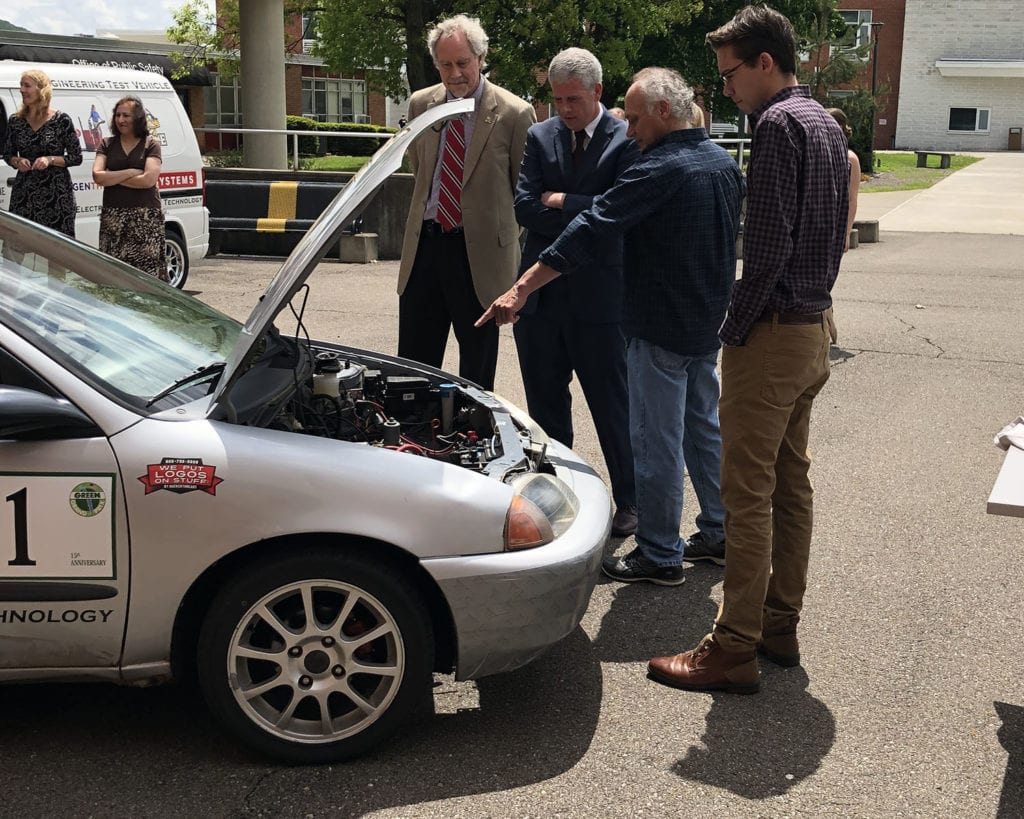
The silver Chevy Metro doesn’t look like a trophy-winning race car, but it wasn’t competing for speed.
Instead, it took top honors at the 2019 Toyota Green Grand Prix as the most efficient vehicle – besting Teslas, Priuses, Chevy Volts and other hybrid vehicles on the market. During the April 5 competition at Watkins Glen, the car used nearly 19 kilowatts of electricity to travel about 100 miles – the equivalent of 180 miles per gallon in a gas-filled car.
What’s even more amazing: this hyper-efficient electric vehicle was the creation of SUNY Broome students.
“Pretty much everything on this car is a student project,” said student team-member Mike DiGiacomo, as he walked Broome County Executive Jason Garnar through the car’s many components, from its LED lights and lithium ion battery pack to the solar panel on its roof.
Ten students participated on the team behind the car, under the direction of Professor Gary DiGiacomo and technical assistant Donovan McCarty: Mike, Jeff Anderson, Ali Abdur-Rahim, Billy Judd, Kathryn Proppe, Chase Roy, Sam Rickenback, Curtis Eaton, Madison Wetzel and Gavin Pica.
The car has a complicated history. It was damaged in a flood, then converted to electric by the owner of Sarnicola Simulation Systems, who then donated it to the TechWorks Museum. There it sat in a parking lot, ransacked by vandals before ending up at SUNY Broome.
“It needed some TLC. We looked at this as a rebuild,” said Mike DiGiacomo, who drove the car during the Green Grand Prix.
Students made all the decisions on the project, installing a new battery pack, low-power LED lights and a new third brake light, as well as instrumentation to monitor energy use. The project also received support from sponsors, including RedBarn, HackerThreads, BAE Systems, Raymond Corp and the IEEE club at SUNY Broome.
The Metro’s fastest recorded speed is 70 mph and it drives just like a regular car, Mike DiGiacomo said. As a hyper-efficient race car, it does lack amenities that many drivers prefer – such as a car radio.
Professor Diana LaBelle, co-chair of the Engineering Technologies Department, noted that the competition gave students a chance to practice what they learned in the classroom on a real project with design constraints, deadlines and system integration challenges.
“They get to hone their critical thinking skills and work as a team. We know that these are the skills that employers want to see because they tell us so,” she said.
Learn about SUNY Broome’s degree options in STEM.
“You can theorize anything, but if you can make it work, it’s a completely different level. We’re about making things work,” added Professor Gary DiGiacomo.
Broome County Executive Jason Garnar, a proud SUNY Broome alumnus, congratulated the winning team on May 20 – and took the Metro out for a spin around campus.
“It actually does look like the car from Back to the Future,” he observed.
“It may have been our inspiration!” Professor DiGiacomo said.


